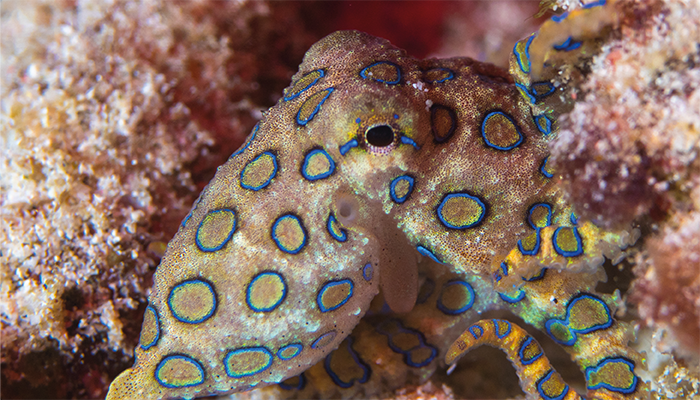Refined gold. The two most common screening methods for liver cancer diagnosis, imaging tests and serological marker detection, are limited in terms of their sensitivity; whereas puncture biopsies, while accurate, are very painful. Surface-enhanced Raman spectroscopy (SERS) has extremely low detection limits and ultrahigh sensitivity, but selecting an appropriate substrate has limited its application in disease diagnosis. In a recent study, researchers from Kunming, China, used Ag@SiO2 nanoparticles as the SERS-enhanced substrate – which have high absorption and conversion efficiencies while also being biocompatible (which regular gold isn’t). The result? A classification accuracy of 97.98 percent, sensitivity of 97.14 percent, and specificity of 98.44 percent.

Credit: Greater blue-ringed octopus (Hapalochlaena lunulata) by Rickard Zerpe / CC BY
What lies beneath. We’ve all seen plastic litter washing up on beaches or floating atop rivers, but how much plastic lies at the bottom of lakes? Well, we don’t really know because surveys are few and far between. “I think that’s a real issue, because when we think about how plastics may be moving in freshwater systems, there's a good chance that they'll end up in a lake,” said Monica Arienzo, a lead author of a study surveying Lake Tahoe’s (USA) lakebed. In the study, scuba divers collected litter from a lakebed – counting 673 plastic items. Attenuated total reflection Fourier transform infrared spectroscopy was used to characterize the plastic polymers – data that the researchers believe can be used in conjunction with microplastics data to determine their source.
Octopus-inspired camouflage. Researchers from the University of California, Irvine, USA, drew inspiration from the unique blue rings of the Hapalochlaena lunulata octopus – which can camouflage itself by changing the size and color of the patterns on its skin – to develop a camouflage system with tunable spectroscopic and fluorescent properties. The researchers characterized the materials using a combination of NMR spectroscopy and mass spectrometry. "For this project, we worked to mimic the octopus' natural abilities with devices from unique materials we synthesized in our laboratory, and the result is an octopus-inspired deception and signaling system that is straightforward to fabricate, functions for a long time when operated continuously, and can even repair itself when damaged,” said senior co-author Alon Gorodetsky.
Fashionable recycling. The fashion industry has aggravated textile waste – producing approximately 2-8 percent of global gas emissions. Despite the efforts to implement “fiber-to-fiber” recycling, most clothes are difficult to process because they are made up from various materials – especially elastane, which causes blockages and other issues during recycling. That is why researchers from the Institute of Chemical, Environmental and Bioscience Engineering, Austria, developed a spectroscopy-based sorting technology to detect elastane – to eventually dissolve it with a non toxic solvent and isolate pure materials like cotton and polyester.
Functional near-infrared spectroscopy confirms that visual-motor illusion (VMI) aids early stages of motor learning – which could lead to treatment and rehabilitation for hemiplegic stroke patients. Link
Scientists analyzed infants’ brains with functional magnetic resonance imaging (fMRI) and near-infrared spectroscopy (NIRS) to explain how different molecules change when babies react to touch. Link
Researchers develop a rapid method to identify bacteria (Pseudomonas aeruginosa) using Raman spectroscopy. Link
Greek research group reveals how electrical impedance spectroscopy could enhance cervical cancer diagnosis – thanks to higher sensitivity than traditional methods. Link
X-ray absorption spectroscopy, Raman spectroscopy, and computational modeling using density functional theory reveals a “cooperative” behavior in zinc-ion battery electrolytes – providing a blueprint for future battery design with wider development opportunities. Link




